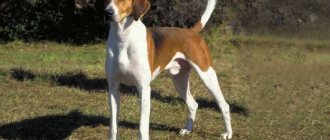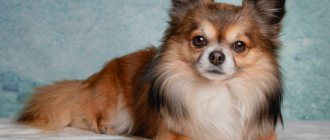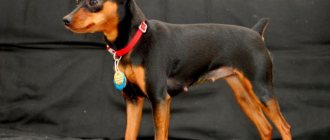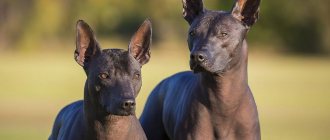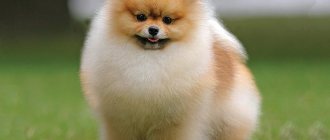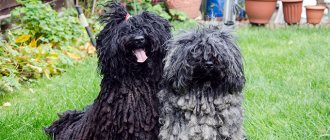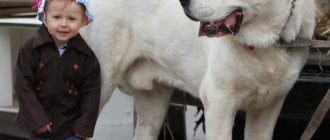Hounds are one of the groups of hunting dogs. All its representatives are distinguished by a ringing voice with a characteristic yodel and are intended for driving wolves, roe deer and wild boars.
The peak of popularity of these four-legged animals came in the Middle Ages, but due to public indignation and numerous hunting bans, they had to be hastily reclassified as ordinary companions. Despite this fact, the animals still managed to maintain their passion for searching and pursuing wild animals and birds.
Estonian hound
Belongs to the section of medium-sized dogs, maximum height is 52 cm, weight is no more than 20 kg. A universal hound, the physical qualities of which allow it to hunt not only small animals, but also larger animals: wild boars, deer, elk, etc. The animal is not at all aggressive towards people, thanks to which it can be not only a hunting dog, but also act as a companion. In Russia, a small number of breeders are engaged in breeding the breed, so dogs are usually sent to their homeland for a purebred Estonian.
Health
The English Foxhound is one of the fairly healthy breeds. Among genetic diseases, diseases of the endocrine system (hypothyroidism), organs of hearing and balance (deafness caused by the action of the dominant merle gene), hematopoietic and lymphatic systems (Pelger-Huet anomaly, thrombasthenia), cardiovascular system (cardiomyopathy), skin and mucous membranes (primary seborrhea), liver and pancreas (chronic active hepatitis), nervous system (hound ataxia), skeleton (hip dysplasia, undershot, overshot).
Russian hound
It has a strong build and great endurance during hunting. The size of the dog is average: its weight is between 25-30 kg, and its height does not exceed 68 cm.
On the basis of Russian hounds, the Russian piebald hound was later bred, which appeared through crossing with English foxhounds.
Representatives of the breed are characterized by a loud bark, with which they accompany the enclosure of prey. The animal can easily work both in a team and alone. It is best to keep the dog in a private home, as hounds need space to move.
Health
The English Foxhound is one of the fairly healthy breeds. Among genetic diseases, diseases of the endocrine system (hypothyroidism), organs of hearing and balance (deafness caused by the action of the dominant merle gene), hematopoietic and lymphatic systems (Pelger-Huet anomaly, thrombasthenia), cardiovascular system (cardiomyopathy), skin and mucous membranes (primary seborrhea), liver and pancreas (chronic active hepatitis), nervous system (hound ataxia), skeleton (hip dysplasia, undershot, overshot).
Bavarian mountain hound
The history of this breed begins in Germany, where dogs were used as hunters who knew how to take a bloody trail. They have performed this role since the Middle Ages, when weapons could easily leave bleeding wounds on prey, through which it could be tracked. Thus, Bavarian dogs differ from hunting dogs, as they are used primarily as tracking dogs.
Their weight is 20-25 kg, and their height is within 48 cm for females and 52 cm for males. The breed standard requires a short, shiny coat that is hard to the touch. The color of dogs is usually red or brindle with a variety of shades.
Distinctive features
Hound dog breeds, just like greyhounds and pointers, belong to the hunting group. Their main task is to drive the wild beast under the owner’s weapon. They can spend from two hours to several days in pursuit. These dogs are known for their endurance, keen sense of smell, high speed of movement and ringing bark.
Hunting hounds also have external differences from other breeds:
- ears hang freely, tips pointing down;
- the bridge of the nose is straight;
- black lobes;
- lips fit tightly to the jaw;
- large skull;
- the back is straight;
- large breasts;
- muscular paws.
Dogs of these breeds are also distinguished by short, straight hair. Most often they have wolf, merle, red-yellow, piebald or black-backed colors.
Finnish hound
The name of the dog in its native language sounds like suomenajokoira. Its homeland is Scandinavia and Finland, where the animal was intended to corral small prey: foxes, hares, raccoons. Thanks to the climatic features of Finland, the hound can easily tolerate low temperatures and feels comfortable during winter hunting.
A distinctive feature of the breed is hunting alone.
A dog can chase prey several kilometers from its owner and notify about its find with a loud bark. The animal's height reaches 52 cm, and its weight is between 20-25 kg. The Finnish hound is distinguished by great endurance and balance, which makes it a good companion outside the hunt.
Training
The English Foxhound, like any other hunting breed, requires regular support for its instincts and skills. This dog responds very well to firm and active training due to its loyalty to its owner and its keen, inquisitive mind. Usually there are no problems with training or learning to hunt, the main thing is to do it regularly and intensively.
The English Foxhound is the epitome of strength, grace, intelligence and an easy-going, playful nature. This breed is best owned by energetic people who love traveling , hunting or cycling or walking, that is, those who are able to provide these dogs with an active lifestyle.
If you have anything additional to share about the English Foxhound, then leave your comments or reviews that will help future owners understand this noteworthy breed.
French hound
This breed is considered one of the most expensive in France, but fans of the French Hound believe that it is worth it. The animal is usually used to hunt large prey and can follow it along a bloody trail. Its weight varies depending on the type of dog. It ranges from 17-32 kg, and its height does not exceed 68 cm. The hound has excellent endurance, thanks to which it can chase prey for a long time until the victim is completely exhausted. In addition to hunting, the dog is successfully used as a domestic companion due to its calm and friendly disposition.
Beagle Hound
The birthplace of the breed is England, where beagles were intended for hunting burrowing animals. They are distinguished by great liveliness of character, mobility and independence. Sometimes an animal can be stubborn and willful, which is why the owner needs to educate him from childhood.
Beagles have a developed sense of smell, which is why they can often be found at customs. There, animals are responsible for finding explosives.
The dog's height does not exceed 40 cm, and its weight does not exceed 11 kg. At the same time, females are inferior to males in size. Beagles are usually tri-colored (a combination of white, red and black) or bi-colored (white with hints of red). It is rare to see plain white or black dogs.
Owner reviews
Sergey. I've always had hounds. I am a hunter myself and have a special love for hounds. I first saw a Deerhound with a companion abroad. Then I came on vacation. The dog's work captivated me! Powerful, fast, dexterous! I was excited - I really liked the dog. We had to wait a year and a half for the puppy - the breed is rare, the appointment was a year in advance. Now my dog is almost five - full of energy and always ready to work. I don’t advise anyone who dreams of a security guard to take it. But he is an excellent companion. He always senses the mood and knows when to be naughty and when it’s better to lie quietly in place. Very pleased with the breed.
Elena. My husband has been trying to persuade me to adopt a deerhound for a long time. I didn’t agree for a long time - the dog is large, my son is very small. I brought a three-month-old puppy in spite of. He turned out to be so nice that I couldn’t refuse. The dog is now almost three years old. My husband spends all hunting seasons with him (he works not only with deer, as it turns out), and the rest of the time the dog lives with us. We made him an insulated booth, but we don’t close the enclosure. We often let the dog into the house. They have a special understanding with the child. The Deerhound is very flexible and intelligent. Knows when to be naughty and when to be careful. I recommend it to active people. It is better not to take a dog into the apartment.
Bloodhound
A type of hound appeared in Belgium, where it was used not only as a hunter, but also as a detective. Today, the bloodhound is intended for driving foxes and small game. The name of the breed translates as blood dog and gives rise to several theories about its origin. According to the first version, bloodhounds got their name due to their ability to search for a wounded animal by the smell of blood. According to another theory, the name emphasizes the purebred, noble origin of the breed.
Animals have pronounced gender differences: females are significantly inferior to males in size. Their height is 62 cm, and for males - 68 cm. The weight of females is 40-48 kg, males - 46-54 kg. The dogs perform well both in hunting conditions in open areas and in difficult terrain.
Mating
When selecting a partner for mating, not only the achievements of the female and male, but also their parents are taken into account.
- Homogeneous selection. A couple is selected based on similar characteristics: exterior, origin, constitution. Moreover, the male must be better in terms of breeding characteristics in order to pass on his genes to the offspring.
- Heterogeneous selection. Males are selected that are much superior to their partners. This allows you to correct deficiencies in the offspring’s appearance.
Mating should begin after the female's third heat - this way her body will be ready to bear offspring.
Poitevin
The first representatives of the breed appeared in France, but due to the outbreak of a rabies epidemic, many animals died. Gradually, through the efforts of breeders, the population was restored, and dogs began to be used to corral wild boars and foxes. Poitevin can also participate in wolf hunting. The dogs are quite large, weighing up to 30 kg with a height of about 70 cm. They have a good sense of smell, allowing them to stay on the scent and pursue prey for a long time. Animals are easy to train; they are characterized by attentiveness and patience in learning new skills.
Application
In South Africa, Ridgebacks were used to hunt lions and other large animals.
In urban environments, he is tasked with guarding property and protecting the territory. Although even now they take him with them to hunt foxes, birds and other game.
Sometimes you can see these ridges in greyhound racing or agility (running on an obstacle course).
Sleepy baby ridge
American Foxhound
The breed was developed in America to detect wild boars and foxes. Hence the second name of the breed - fox hound. In addition, they can work to corral possums, bears and raccoons. American Foxhounds have a well-developed sense of smell, allowing them to navigate in forests or fields. Males reach 63 cm at the withers, and females - 61 cm. The animal is distinguished by good intellectual abilities, a strong physique and excellent physical characteristics. The American is considered a balanced dog that gets along well with its relatives and family members.
Health
The English Foxhound is one of the fairly healthy breeds. Among genetic diseases, diseases of the endocrine system (hypothyroidism), organs of hearing and balance (deafness caused by the action of the dominant merle gene), hematopoietic and lymphatic systems (Pelger-Huet anomaly, thrombasthenia), cardiovascular system (cardiomyopathy), skin and mucous membranes (primary seborrhea), liver and pancreas (chronic active hepatitis), nervous system (hound ataxia), skeleton (hip dysplasia, undershot, overshot).
English hound (coonhound)
These dogs are called raccoon hounds and have several varieties of the breed. Coonhounds are distinguished by physical strength and endurance, as well as great diligence when hunting. Their courage and dexterity allow them to hunt both small prey and large animals: deer, bears. In a family, dogs prove to be very affectionate and sociable pets.
Today there are the following colors of the breed:
- speckled red;
- red;
- mottled blue;
- black and tan;
- Walker Coonhound (tricolor of black, tan and white).
Of all the varieties, only the black and tan species has been officially recognized.
How to choose a puppy
The first thing when choosing a puppy is to focus on the conditions in which the litter is kept. The baby must be strong, active and well-fed.
You should not buy a puppy before two months of age. It is better to choose an animal in person rather than online. The puppy must have all breed standards - this should be checked immediately, paying special attention to the bite, the number of incisors, the proportionality of the build and the shape of the paws, which should be straight.
Before buying, you need to look at the documents for the dog, check the pedigree of the parents and the presence of the necessary vaccinations.
Lithuanian hound
The first attempts to breed the breed were made at the beginning of the 20th century, when breeders from Lithuania wanted to revive the Kurland Hound, valued for its high hunting skills. The following dog breeds were used for this:
- Russian hound;
- bloodhound;
- Polish hound;
- beagle
As a result, the crossing of breeds led to the appearance of the Lithuanian hound, which had excellent physical qualities and great psychological stability. The weight of dogs can reach 32 kg and height – 61 cm. The animal is easy to train and is very obedient. It is capable of mastering not only basic commands, but also complex tricks.
Suitable nicknames
In order to be able to contact your pet without any problems while hunting, you need to choose a name wisely. Long, polysyllabic options are, of course, beautiful, but they are not suitable for quick response. Therefore, the nickname should consist of 1-2 syllables. For boys Russian hounds the following are suitable:
- Bushui;
- Call;
- Bassoon;
- Polaz;
- Bolt;
- Alarm;
- Bow.
For female hounds - real hunters - no less interesting names are suitable:
- Shumka;
- Magpie;
- Screw;
- Fun;
- Lute;
- Rogue;
- Cone.
The name can be chosen based on hunting qualities, for example, if the animal is very noisy, then it can be called Gong or Screamer.
Russian hounds on the hunt
Biyi
The breed originated in France and was used primarily for hunting deer and roe deer. The dogs are distinguished by their great physical strength, their weight reaches 30 kg and their height is 67 cm. During a hunt, the timbre of a hound’s voice can change depending on the prey being pursued. Experienced hunters can use this feature to determine which animal the dog is chasing.
The Biyi was developed from ancient French breeds that no longer exist today. Thanks to them, he got tall height and red spots on his body.
The animal does not get along very well with other dogs, as due to its proud nature it constantly claims to be the leader. But with members of his family, biyi is obedient and very affectionate.
Division into groups
There are several classifications of dogs of this species, depending on the criterion that underlies the division.
For example, based on the number of simultaneously working animals, they are distinguished:
- Hounds working one at a time (example: Laufhund);
- Dogs performing in pairs or in a pack (example: Russian hounds, beagles, etc.).
By type of sequence there are:
- Dogs for complete (mountain hunting). Here the animals follow a pack of horses, and when they are brought close to the habitat of the prey (wolf, fox, etc.), they begin searching for it and racing together. The process stops when the prey reaches the gun or a group of greyhounds. A typical example is the English Foxhound.
- Dogs for hunting on foot. This includes dogs capable of working alone or with a partner. The dog must search for prey by following the scent, being far from the owner, follow it for a long time, up to several days, read the confused tracks, and notify the owner of his location with his voice. Examples: Basset Hound, Breton Griffon and Nivernes Griffon.
- Dogs for working on the blood trail . Hounds of this group are used to track wounded animals, usually ungulates. The dog must remain silent while following the blood trail; its voice is given only when it reaches its prey. Examples: Bloodhound, Estonian and Bavarian hounds, Poitevin.
There are also Western, Eastern and Brutish types of hounds. Dogs of the first option are distinguished by rounded ears, a powerful blunt muzzle, and short hair (for example, bloodhounds).
- Orientals have a flat wolf-type nose, a medium-length tail, narrow ears with a sharp angle, a muzzle and legs with short hair, and they also lack dewclaws (for example, Russian and Polish hounds).
- The busty type does not have a high running speed, but they are very durable. Dogs of this species are characterized by a short, rounded skull and smoothly rounded ears (for example, the Niverney griffon, Otterhound).
The most popular classification of this type is based on size. There are small, medium and large species.
Transylvanian Hound (Erdeli-opo)
Today it is a fairly rare breed, mainly used in its homeland. Transylvanian hounds are divided into two subspecies:
- Small. The height of dogs reaches 45-50 cm at the withers.
- Big. Animals have a height of 55-65 cm.
Despite the large difference in size, the weight of hounds does not exceed 35 kg. The larger the individual, the more fit it is. Dogs have an independent, proud character and recognize only one person as a leader. A special trusting relationship is established with him. The pet is ready to work under the command of the owner, but it needs early training.
Care and maintenance
The English hound does not like cramped spaces, so keeping it in a city apartment is not recommended. She will feel uncomfortable and will begin to damage furniture and other items. Suitable for active people and nature lovers. The pet needs long walks with active games and exercise.
Short hair must be cleaned with a special brush or stiff comb. The dog doesn't need a haircut. Bath only when absolutely necessary. You should brush your teeth regularly with an edible toothpaste for dogs to prevent the formation of tartar. After long walks, the paws are checked for cuts. If any appear, disinfect them and lubricate them with special wound-healing agents.
The breed is prone to ear infections and may become infected with parasites. The ears are checked and external dirt is removed with a cotton swab. Periodically clean the inside. To do this, a drop of a special product is dripped into the ear canal and massaged. When the dog is released, it vigorously shakes its head, thus getting rid of dirt and sulfur mass. The ears should be clean, without redness, damage or unpleasant odor. The eyes are washed with strong tea leaves or chamomile decoction. Once every 2 weeks, trim your pet’s nails with a nail clipper.
The breed is characterized by profuse salivation. It is necessary to wipe the dog's face, otherwise irritation and infectious diseases may occur.
Feeding
Feed the dog dry food or natural food at the same time. Food should not be hot or cold, but warm. When feeding, it is necessary to take into account the age, activity and gender of the dog. Puppies up to 3 months are fed 6 times a day, an adult dog - twice a day. The main diet is meat, offal and fish. If the dog is sick, weakened or has undergone surgery, it must be given heat-treated liver. Beef bones are a must. Minced meat is not very well absorbed by the body, so it is better to avoid it. Fish is not given together with meat, but separately, replacing it. Sea fish can be given raw and boiled, after removing all the bones; river fish - only in boiled form.
In addition, it is recommended to give fermented milk products and porridge cooked with milk. An egg is given once a week. It is good for wool. It is recommended to grate fruits and vegetables on a coarse grater, and chop greens. Additionally, fish oil, vegetable oil, vitamins and minerals are added. Prohibited foods include pickles and marinades, spices, sweets, baked goods, raw protein, and legumes. If the choice falls on dry food, then it is recommended to purchase premium or super premium products.
The dog is prone to overeating, so you need to monitor the amount of serving.
Harrier
This dog breed is also famous mostly in its homeland in England. The harrier is distinguished by its strong build and stockiness, despite the fact that it is intended for driving small, agile game. This is explained by the fact that animals were once used during horse hunting, which required from them not only agility and speed, but also great endurance, the key to which was muscle mass. Harrier is of medium size: height varies from 48 to 53 cm, and weight is between 20-27 kg. There are no pronounced gender differences among representatives of the breed.
Third section: related breeds
The exact origin of related breeds has not been established. Despite this, their appearance, character and working qualities are the same as other hound breeds.
Dalmatian
The first mentions of spotted Dalmatians date back to the 16th-17th centuries. Their images adorn churches and monasteries, as well as portraits of influential nobles.
In the 18th century, English breeders began breeding Dalmatians, noting the dogs’ amazing ability to run for a long time tirelessly, along with a horse-drawn carriage. For this reason, dogs began to be involved in guarding carriages and hunting game.
Dalmatians are prone to deafness. Hearing problems occur in 12% of newborn puppies.
“ The most interesting thing about the Dalmatian
Rhodesian Ridgeback
The Ridgeback is the only South African hound to achieve international recognition. Until the 19th century, it was used to protect livestock, and only after that the European nobility, who sailed to Africa from the Old World, became interested in it.
Gradually, jackal-like dogs with an oblong comb of wool on their backs were retrained as lion beaters. During breeding work, enthusiasts added genes for mastiffs, Great Danes, pointers, terriers, retrievers and bloodhounds, increasing their initial strength and speed.
Do you like the article? 0
Laufhund
These hounds originated in Switzerland and have a rich pedigree. Hunters use them when driving wild boars, foxes, roe deer and hares. The animal tolerates traveling long distances well and feels best in a field or on a plain. It is distinguished by its intelligence and sociability, which allows it to well understand the desires of the owner.
Laufhunds in the process of formation were divided into two subspecies. Their description is as follows:
- Tall-legged. Their height varies from 48 to 59 cm in males and from 46 to 57 cm in females. Weight does not exceed 23 kg.
- Low-legged. The height of males is 25-41 cm, females - 32-38 cm. Weight no more than 18 kg.
A characteristic feature of Swiss hounds is their deep eyes, outlined with a black border.
Appearance
English Foxhound in 1915
Well balanced, powerful dog with clear lines. The head has a flat and wide skull. The occipital protuberance is well developed. The transition from the forehead to the muzzle is moderately pronounced. The muzzle is square and long, the nostrils are large. The jaws are strong and have a full scissor bite. Eyes with an attentive expression, brown or hazel. The ears are hanging, pressed tightly to the cheekbones.
The neck is dry, well developed. The back is wide and straight, the loin is somewhat convex. The chest is deep with very long, well sprung ribs. The tail is saber-shaped, set high, kept at the level of the back, but never thrown over it. Limbs are strong and muscular; The paws are round, dense, the toes are arched, with strong pads and claws.
The coat is short, close-lying, and protects the dog well from bad weather. Color - any color typical of hounds. Usually white, occupying about a quarter of the area, with black spots, around which there is a bright red border in the form of a blush, or lemon piebald.
The height at the withers of males and females is approximately 58 to 64 cm, weight is 27-34 kg.
Otterhound (otter hound)
The breed originates in England, where it was at the royal court for a long time. She was given the name otter hound, which emphasizes her specialization. The animal was not only fast and insightful, but also had an amazing sense of smell, allowing it to pick up the scent of an otter several hours after its disappearance. Dogs can easily hunt on and under water.
Otterhounds have webbed toes that allow them to swim well in water.
The animals are quite large: their weight can reach 50 kg and their height is 69 cm.
Nurseries
The price of a hound puppy depends on many factors, from the seller (private advertisement or professional kennel) to the prevalence of the breed in the buyer’s country. Some of the kennels involved in breeding hounds include:
- Nazoro (Khimki);
- Altai (Altai);
- Skywood Hunter (Moscow).
If you take a pet from your hands, the cost of the puppy will be significantly lower. The price for popular breeds in Russia can be 10,000-15,000 rubles. However, the quality suffers, since the animal may have various defects. Licensed nurseries charge on average 25,000-30,000, but the cost of puppies of various breeds can reach up to 80,000 rubles.
Socialization
Noisy but not aggressive dog. The Austrian Bracket gets along well with his own kind. The dog hunts in a pack, so he is absolutely accustomed to his relatives.
The pet is friendly with strangers, but acts aloof. If you pet him, he will endure it; he will not impose himself with affection.
Like any self-respecting hunter, he considers living together with other animals beneath his dignity. The cats will be instantly strangled. There will be no wet place left from rodents.
